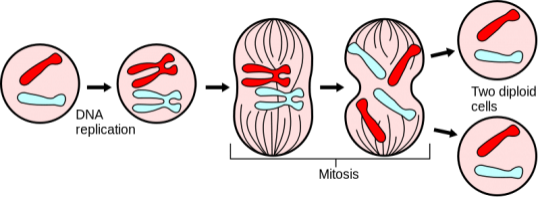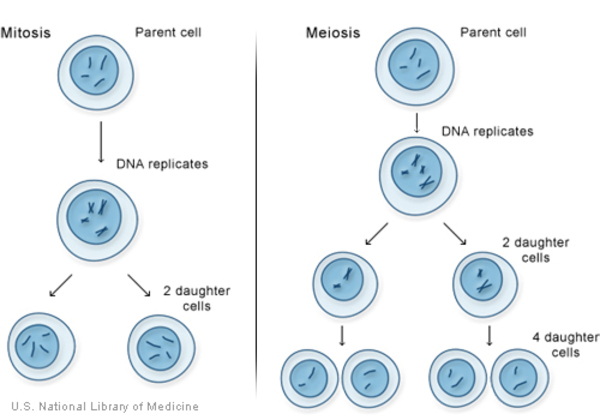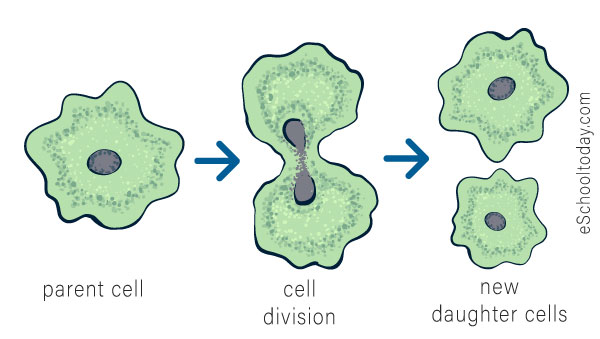Cell Division Study Guide
Introduction
Cell division is a very important aspect of our life, and almost every living being on this planet relies on it to increase its population. Let’s learn about what happens during this crucial process and why it’s so important below.
What is cell division?
Cell division occurs when a parent cell duplicates itself into two or more daughter cells. These daughter cells grow and produce new cells by cell division. This process continues, and is thus known as the cell cycle.

Why do cells divide?
-
To replace old damaged cells with new ones.
-
For growth and reproduction.
-
To repair damaged cells.
An example this is when you fall on the bare ground and the skin of your knee gets damaged. Here, cell division occurs and replaces the damaged cells with new ones, and thus the skin heals.
Types of Cell Division
There are three types of cell division: mitosis, meiosis, and binary fission:
-
Mitosis: Mitosis is known as vegetative division, as in this process the cell produces two daughter cells that are an exact replication of the parent cell. This process takes place in almost every part of our body’s cells.
-
Meiosis: Meiosis produces gamete cells like sperm and eggs rather than identical daughter cells.

- Binary Fission: Binary fission occurs in unicellular organisms, such as bacteria or amoeba. They replicate themselves for growth and cell reproduction.

Phases of Cell Division
There are two major phases of cell division: interphase and the M phase
Interphase: Interphase is a very active part of cell division. Four further stages of cell division occur within it:
-
G0 Phase: The GO phase is the resting phase, as nothing occurs in its part of the cell cycle.
-
G1 Phase: In the G1 phase, the cell increases in size, and all of the contents of the cell duplicate themselves.
-
S Phase: In the S phase, DNA replication occurs.
-
G2 Phase: In the G2 phase, the cell grows more, and certain chemicals develop to prepare what type of cell goes through mitosis.
M Phase: In the M phase, mitosis occurs along with cell separation and the parent cell produces two identical daughter cells. This phase also includes 4 stages:
-
Prophase: During prophase, the nuclear membrane dissolves and chromosomes form from condensing chromatin.
-
Metaphase: During metaphase, the centrioles of the cell become spindle fibers, which then attach to the chromosomes and align them at the equator of the cell.
-
Anaphase: During anaphase, the spindle fibers shrink and pull apart the chromosomes into two pieces called chromatids which are then pulled to the poles of the cell.
-
Telophase: During telophase, the spindle fibers disappear and the nuclear membrane reforms.
✅ Conclusion
-
Cell division is essential for us to produce new life, replace dead cells, and regenerate damaged cells.
-
The cell diving process can be classified into the following types: mitosis, meiosis, and binary fission.
-
Different stages of cell division are interphase, subdivided into G0, G1, S, G2 stages, and M phase, further divided into Prophase, Metaphase, Anaphase, and Telophase.
FAQs
1. What are the 3 types of cell division?
The three types of cell division are (i) Mitosis, (ii) Meiosis, and (iii) Binary fission.
2. What is cell division, and how does it work?
Cell division is replicating a parent or original cell into two or more similar daughter cells. Cells repeatedly go on dividing to produce more than one cell, and this repeatable process is known as the cell cycle.
3. Why do cells divide?
-
To ensure the growth of living beings.
-
To replace the damaged cells with new ones.
-
To repair any worn-out cells.
-
For the reproduction process.
-
To maintain a high surface area to volume ratio of food, waste, and gas exchange to transfer contents in and out of the cell.
4. What is the major function of cell division?
The essential and major function of cell division is the reproduction, gamete formulation, and growth of living things.
5. What is the difference between mitosis and cell division?
Usually, when people are referring to cell division, they mean the process of mitosis. During mitosis, the cell nucleus divides to produce two identical nuclei. Cell division is the process by which the entire cell divides into daughter cells, not just the nucleus.
6. Which type of cells divides by mitosis?
Somatic, eukaryotic, and stem cells.
We hope you enjoyed studying this lesson and learned something cool about Cell Division! Join our Discord community to get any questions you may have answered and to engage with other students just like you! Don’t forget to download our App to experience our fun, VR classrooms – we promise, it makes studying much more fun! 😎
]]>